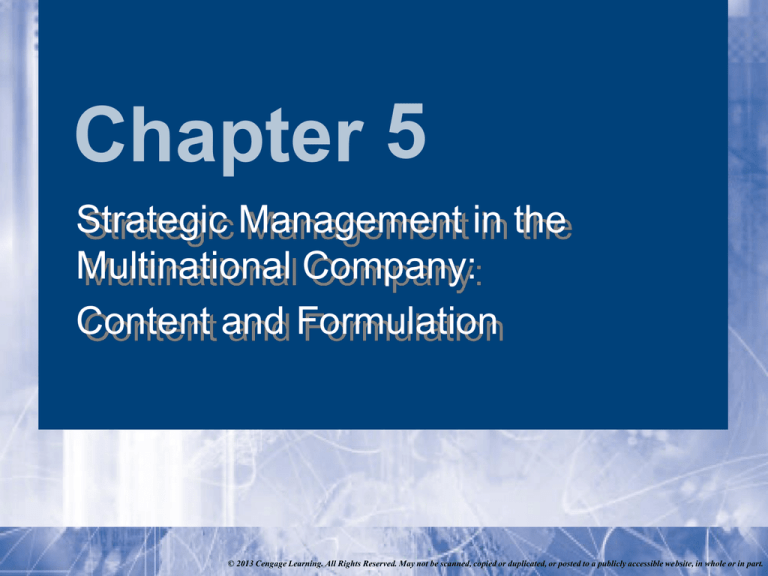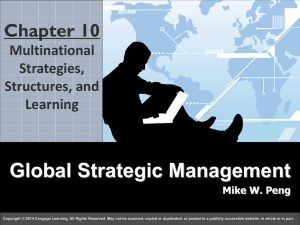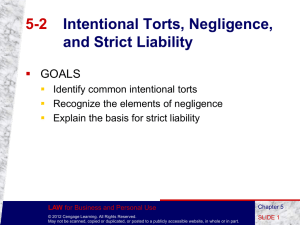
Chapter 5
Strategic Management in the
Multinational Company:
Content and Formulation
© 2013 Cengage Learning. All Rights Reserved. May not be scanned, copied or duplicated, or posted to a publicly accessible website, in whole or in part.
Learning Objectives (1 of 2)
• Define generic strategies of differentiation and low cost
• Understand how low-cost and differentiation strategists
make money.
• Recall multinational examples of the use of generic
strategies.
• Understand competitive advantage and the value chain
and how they apply to multinational operations.
• Understand how multinational firms use offensive and
defensive strategies.
© 2013 Cengage Learning. All Rights Reserved. May not be scanned, copied or duplicated, or posted to a publicly accessible website, in whole or in part.
Learning Objectives (2 of 2)
• Understand the basics of multinational diversification.
• Understand how to apply the traditional strategy
formulation techniques, industry and competitive
analysis, and company situation analysis to the
multinational company.
• Realize that the national context affects both
convergence and divergence in the strategies used by
multinational companies.
© 2013 Cengage Learning. All Rights Reserved. May not be scanned, copied or duplicated, or posted to a publicly accessible website, in whole or in part.
Basic Strategic Content
Applied to the
Multinational Company (1 of 2)
• Strategy:
• the central, comprehensive, integrated, and
externally oriented set of choices structuring how a
company exploits its core competencies to achieve
its objectives
© 2013 Cengage Learning. All Rights Reserved. May not be scanned, copied or duplicated, or posted to a publicly accessible website, in whole or in part.
Basic Strategic Content
Applied to the
Multinational Company (2 of 2)
• Ideally, a strategy must address important areas such
as:
• which businesses a company wants to be in
• how the company will create presence in a market
• how the company will win customers
• Multinational companies use many of the same
strategies practiced by domestic companies.
© 2013 Cengage Learning. All Rights Reserved. May not be scanned, copied or duplicated, or posted to a publicly accessible website, in whole or in part.
Competitive Advantage and
Multinational Applications of
Generic Strategies (1 of 2)
• Generic Strategies are basic ways for companies to
achieve and sustain a competitive advantage
• Competitive Advantage:
• when a company’s strategy creates superior value for
targeted customers, and is too difficult or costly for
competitors to copy
• Two primary ways to gain a competitive advantage:
• Differentiation
• Low cost
© 2013 Cengage Learning. All Rights Reserved. May not be scanned, copied or duplicated, or posted to a publicly accessible website, in whole or in part.
Competitive Advantage and
Multinational Applications of
Generic Strategies (2 of 2)
• Differentiation Strategy:
• finding ways of providing superior value to customers (i.e.,
exceptional quality, unique features, rapid innovation)
• Example: BMW’s high-quality, high-performance sports cars
• Low-cost Strategy:
• Produce or deliver products or services equal to those of
competitors, but at a lower cost
• Example: Korean semiconductor firms’ low-cost and
productive labor
© 2013 Cengage Learning. All Rights Reserved. May not be scanned, copied or duplicated, or posted to a publicly accessible website, in whole or in part.
How Do Low-Cost and
Differentiation Firms
Make Money?
• Differentiation:
• Customers often pay a higher price for the extra value of a
superior product or service
• Example: Swiss chocolatier Tobler-Jacobs charges more
for its specially produced (not mass-produced) chocolate
• Low-cost
• Additional profits come from cost savings at every step of
the process
© 2013 Cengage Learning. All Rights Reserved. May not be scanned, copied or duplicated, or posted to a publicly accessible website, in whole or in part.
Exhibit 5.1:
Costs, Prices, & Profits for
Differentiation & Low-Cost Strategies
© 2013 Cengage Learning. All Rights Reserved. May not be scanned, copied or duplicated, or posted to a publicly accessible website, in whole or in part.
Focus Strategy
• Strategies can be further subdivided on the basis of
competitive scope:
• Competitive scope: how broadly a firm targets its
products or services
• Narrow competitive scope for limited products or
only certain buyers or geographic areas
• Broad competitive scope when many products and a
large range of buyers are targeted
© 2013 Cengage Learning. All Rights Reserved. May not be scanned, copied or duplicated, or posted to a publicly accessible website, in whole or in part.
Exhibit 5.2:
Porter’s Generic Strategies
© 2013 Cengage Learning. All Rights Reserved. May not be scanned, copied or duplicated, or posted to a publicly accessible website, in whole or in part.
Competitive Advantage and
the Value Chain
• A firm can gain competitive advantage by finding
sources of differentiation or low costs in its activities.
• The value chain is a convenient way of looking at the
firm’s activities.
• Value Chain:
• all the activities that a firm uses to design, produce,
market, deliver, and support its product
© 2013 Cengage Learning. All Rights Reserved. May not be scanned, copied or duplicated, or posted to a publicly accessible website, in whole or in part.
Exhibit 5.3:
The Value Chain
© 2013 Cengage Learning. All Rights Reserved. May not be scanned, copied or duplicated, or posted to a publicly accessible website, in whole or in part.
Components of
the Value Chain (1 of 2)
• Primary activities and support activities:
• Primary Activities: the physical actions of creating,
selling, and after-sale service of products
• Upstream: early activities in the value chain,
including Research & Development (R&D) and
dealing with suppliers
• Downstream: later value chain activities such as
sales and dealing with distribution channels
© 2013 Cengage Learning. All Rights Reserved. May not be scanned, copied or duplicated, or posted to a publicly accessible website, in whole or in part.
Components of
the Value Chain (2 of 2)
• Primary activities and support activities (cont’d):
• Support Activities:
• systems for human resources management,
organizational design and control, and a firm’s basic
technology
• Utility of value chain: helps determine internal cost
structure by assessing cost levels of different activities
• Benchmarked against industry & competitors to know if
and where cost advantages or disadvantages exist
© 2013 Cengage Learning. All Rights Reserved. May not be scanned, copied or duplicated, or posted to a publicly accessible website, in whole or in part.
Outsourcing (1 of 2)
• Outsourcing:
• a deliberate decision to have outsiders or strategic
allies perform certain activities in the value chain
• Increasingly, MNCs outsource across borders to take
advantage of lower costs in other countries.
• Outsourcing is a popular and controversial way to
correct internal cost disadvantages.
© 2013 Cengage Learning. All Rights Reserved. May not be scanned, copied or duplicated, or posted to a publicly accessible website, in whole or in part.
Outsourcing (2 of 2)
• When should a multinational company outsource?
• Outsourcing makes sense if an outsider can perform a
value-chain task better or more cheaply.
• However, outsourced tasks should not be ones that are
crucial to the MNC’s ability to achieve competitive
advantage, or the MNC creates competitors.
• The value chain identifies areas in the input, throughput,
and output processes where MNCs can find sources of low
cost or differentiation advantages.
© 2013 Cengage Learning. All Rights Reserved. May not be scanned, copied or duplicated, or posted to a publicly accessible website, in whole or in part.
Distinctive Competencies
• Distinctive Competencies:
• Strengths anywhere in the value chain that allow
companies to outperform rivals
• Examples: Quality, innovation, customer service
• Distinctive Competencies come from two sources:
• Resources
• Capabilities
© 2013 Cengage Learning. All Rights Reserved. May not be scanned, copied or duplicated, or posted to a publicly accessible website, in whole or in part.
Resources and Capabilities
• Resources:
• inputs into the production or service processes.
• Ex.: Buildings, land, equipment, employees
- Resources provide potential capabilities
• Capabilities:
• the ability to assemble and coordinate resources effectively
• For long-term success, capabilities must lead to a
sustainable competitive advantage.
© 2013 Cengage Learning. All Rights Reserved. May not be scanned, copied or duplicated, or posted to a publicly accessible website, in whole or in part.
Sustaining
Competitive Advantage
• Sustainable Stragtegies:
• strategies not easily neutralized by competitors
• Capabilities leading to competitive advantage must be:
- Valuable
- Rare
- Difficult to imitate
- Non-substitutable
© 2013 Cengage Learning. All Rights Reserved. May not be scanned, copied or duplicated, or posted to a publicly accessible website, in whole or in part.
Exhibit 5.4:
How Distinctive Competencies
Lead to Successful Strategies
© 2013 Cengage Learning. All Rights Reserved. May not be scanned, copied or duplicated, or posted to a publicly accessible website, in whole or in part.
Competitive Strategies in
International Markets
• Competitive Strategies are strategic moves
multinationals use to defeat competitors.
- Offensive Competitive Strategies directly attack
rivals to capture market share.
- Defensive Competitive Strategies attempt to beat
back or discourage a rival’s offensive strategies.
- Counter-parries fend off a competitor’s attack in one
country while attacking it in another country.
© 2013 Cengage Learning. All Rights Reserved. May not be scanned, copied or duplicated, or posted to a publicly accessible website, in whole or in part.
Offensive Strategies
Offensive strategies include:
• Direct Attacks: price cutting, adding new features, or
going after poorly served markets
• End-run Offensives: avoid direct competition by
seeking unoccupied, ignored, or underserved markets
• Preemptive Competitive Strategies: being first to obtain
particular advantageous position
• Acquisitions: buying out a competitor
© 2013 Cengage Learning. All Rights Reserved. May not be scanned, copied or duplicated, or posted to a publicly accessible website, in whole or in part.
Defensive Strategies
• Defensive Strategies attempt to:
• reduce the risk of being attacked
• Convince an attacking firm to seek other targets
• Blunt the impacts of any attack
• MNCs may defend themselves at various points in the
value chain, such as:
• Exclusive contracts with best suppliers
• New models to match competitor’s lower prices
• Public announcements about the willingness to fight
© 2013 Cengage Learning. All Rights Reserved. May not be scanned, copied or duplicated, or posted to a publicly accessible website, in whole or in part.
Multinational
Diversification Strategy
• Business-level Strategies pertain to the operation of a
single business.
• Corporate-level Strategies concern how companies
choose their mix of different businesses.
• In Related Diversification, firms start or acquire
businesses similar to their own.
• Example: Nike added a clothing line to its athletic
shoe operation
© 2013 Cengage Learning. All Rights Reserved. May not be scanned, copied or duplicated, or posted to a publicly accessible website, in whole or in part.
Related Diversification
• Firms choose related diversification for 3 reasons:
• Sharing activities
• Transferring core competencies
• Developing market power
© 2013 Cengage Learning. All Rights Reserved. May not be scanned, copied or duplicated, or posted to a publicly accessible website, in whole or in part.
Unrelated Diversification
• Unrelated Diversification: firms acquire businesses in
any industry
• Concern: whether it’s a good financial investment
• May acquire as short term or long term investments
• Benefits: easily establish global brand names,
cross-subsidize, gain access to resources
• Costs: liabilities of newness and foreignness,
coordination, and administrative costs
© 2013 Cengage Learning. All Rights Reserved. May not be scanned, copied or duplicated, or posted to a publicly accessible website, in whole or in part.
Exhibit 5.5:
Examples of Diversified MNCs
© 2013 Cengage Learning. All Rights Reserved. May not be scanned, copied or duplicated, or posted to a publicly accessible website, in whole or in part.
Strategy Formulation:
Traditional Approaches
• Strategy formulation is the process by which managers
select the strategies to be used by their company.
• Popular analysis techniques help understand the:
• Competitive dynamics of the industry
• Company’s competitive position in the industry
• Opportunities and threats faced by their company
• Company’s strengths and weaknesses
© 2013 Cengage Learning. All Rights Reserved. May not be scanned, copied or duplicated, or posted to a publicly accessible website, in whole or in part.
Industry and Competitive
Analysis
• Porter’s Five Forces Model: a popular technique that
can help a multinational firm understand the major
forces at work in the industry and the degree of
attractiveness of the industry
© 2013 Cengage Learning. All Rights Reserved. May not be scanned, copied or duplicated, or posted to a publicly accessible website, in whole or in part.
Industry and
Competitive Analysis (1 of 2)
•
Porter’s Five Forces Model:
1. The degree of competition among existing
competitors in the industry
2. The threat of new entrants
3. The bargaining power of buyers
4. The bargaining power of suppliers
5. The threat of substitutes
© 2013 Cengage Learning. All Rights Reserved. May not be scanned, copied or duplicated, or posted to a publicly accessible website, in whole or in part.
Industry and
Competitive Analysis (2 of 2)
• Managers must understand their industry well to
formulate good strategies.
• Managers must understand dominant economic
characteristics of industries and driving forces.
• Economic characteristics include:
- Market size
- Ease of entry and exit
- Opportunities for economies of scale
© 2013 Cengage Learning. All Rights Reserved. May not be scanned, copied or duplicated, or posted to a publicly accessible website, in whole or in part.
Driving Forces
• Driving Forces are the important changes that have
potential to affect and change an industry in the future:
- Speed of new product innovations
- Technological changes
- Changing societal attitudes and lifestyles
© 2013 Cengage Learning. All Rights Reserved. May not be scanned, copied or duplicated, or posted to a publicly accessible website, in whole or in part.
Key Success Factors (KSFs)
(1 of 2)
• Key Success Factors (KSFs) are important
characteristics of a company or its product that lead to
success in an industry:
- Innovative technology or products
- Broad product line
- Effective distribution channels
- Price advantages
- Effective promotion
- Superior physical facilities or skilled labor
© 2013 Cengage Learning. All Rights Reserved. May not be scanned, copied or duplicated, or posted to a publicly accessible website, in whole or in part.
Key Success Factors (KSFs)
(2 of 2)
• KSFs important characteristics (cont’d)
- Experience of the firm in business
- Cost position for raw materials
- Cost position for production
- R&D quality
- Financial assets
- Product quality
- Quality of human resources
© 2013 Cengage Learning. All Rights Reserved. May not be scanned, copied or duplicated, or posted to a publicly accessible website, in whole or in part.
Competitor Analysis
• Competitor Analysis is a 4-step profile of a competitor’s
strategies and objectives:
• Identifying the basic strategic intent of competitors
• Identifying the generic strategies used and
anticipated to be used by competitors
• Identifying the offensive and defensive competitive
strategies used or to be used by competitors
• Assessing the current positions of competitors
© 2013 Cengage Learning. All Rights Reserved. May not be scanned, copied or duplicated, or posted to a publicly accessible website, in whole or in part.
Exhibit 5.6:
Hypothetical Country-by-Country
Competitive Analysis of Rivals
© 2013 Cengage Learning. All Rights Reserved. May not be scanned, copied or duplicated, or posted to a publicly accessible website, in whole or in part.
Company-Situation Analysis:
SWOT
• Managers must understand what their company can
and cannot do, so must assess:
• Strengths are distinctive capabilities, resources, skills or
advantages relative to competitors; may come from
technological superiority, marketing, etc.
• Weaknesses are the competitive disadvantages of a firm
compared to its competitors.
• Opportunities are favorable conditions in the environment.
• Threats are unfavorable conditions in the environment.
© 2013 Cengage Learning. All Rights Reserved. May not be scanned, copied or duplicated, or posted to a publicly accessible website, in whole or in part.
SWOT Analysis
• SWOT analysis is more complex for MNCs than for
domestic firms.
• Multinationals face more complex general and
operating environments as they operate in more than
one country.
• Environments vary by country, so need to do a country
by country SWOT.
© 2013 Cengage Learning. All Rights Reserved. May not be scanned, copied or duplicated, or posted to a publicly accessible website, in whole or in part.
Corporate Strategy Selection
• A diversified corporation has a portfolio of businesses;
the primary goal is to invest in profitable businesses.
• The major strategic question is which businesses are
targets for growth and investment, and which are
targets for divestment or harvesting.
• The basic tool: matrix analyses
• The most popular is the growth-share matrix of the
Boston Consulting Group (BCG).
© 2013 Cengage Learning. All Rights Reserved. May not be scanned, copied or duplicated, or posted to a publicly accessible website, in whole or in part.
BCG Share Matrix
• BCG Share Matrix: Division into four categories based
on market share and relative market share:
• Stars: the most successful firm
• Dogs: businesses with low market shares in lowgrowth industries
• Cash cows: businesses in slow-growth industries
where company has strong market-share position
• Problem children: businesses in high-growth
industries where company has a poor market share
© 2013 Cengage Learning. All Rights Reserved. May not be scanned, copied or duplicated, or posted to a publicly accessible website, in whole or in part.
Exhibit 5.7:
The BCG Growth Share Matrix for
a Diversified MNC
© 2013 Cengage Learning. All Rights Reserved. May not be scanned, copied or duplicated, or posted to a publicly accessible website, in whole or in part.
The National Context and
Organizational Strategy:
Overview and Observations (1 of 2)
• National context affects organizational design, strategy
formulation, and content through the following
processes:
• The social institutions and national and business cultures
encourage or discourage certain forms of businesses and
strategies in each nation; each has acceptable and
unacceptable ways of doing business.
• Each nation must rely on its available factor conditions for
developing its firms and industries. Local firms have easy
access to local resources, and favor similar strategies to take
advantage of their unique bundle of local resources.
© 2013 Cengage Learning. All Rights Reserved. May not be scanned, copied or duplicated, or posted to a publicly accessible website, in whole or in part.
The National Context and
Organizational Strategy:
Overview and Observations (2 of 2)
• Social institutions and culture determine which resources are
used, how they are used, and which resources are
developed. The resource base limits the strategic options
available to MNCs.
• These points provide a general picture of the process by which
national context affects strategic management.
• Multinational managers can generalize and apply these ideas in
order to understand the actions of rivals or alliance partners in
any country where their firms do business.
© 2013 Cengage Learning. All Rights Reserved. May not be scanned, copied or duplicated, or posted to a publicly accessible website, in whole or in part.
Summary
• The business environment becomes more global every
day, and you will likely work in MNCs.
• Multinational Managers must have a good
understanding of multinational business strategy.
• The chapter lists several ways to formulate competitive
strategies for the global market.
• The Multinational Manager must realize that strategy is
a combination of planned intent and adaptive
reactions.
© 2013 Cengage Learning. All Rights Reserved. May not be scanned, copied or duplicated, or posted to a publicly accessible website, in whole or in part.








